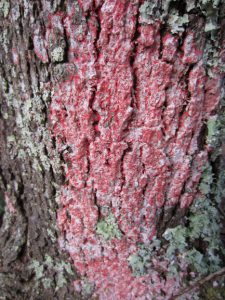You’ve heard of lichen, right? You know what it is, right? It’s a fungus that grows on trees? It is slimy algae? It kills plants? You need to pay someone to remove it?
Well, not exactly.
Lichen is (or lichen ARE) complex organisms—not plant or animal or fungus. Lichen are a composite organism; a fungus provides the structure while bacteria and/or algal plants produce the sugars that feed the entire system!

Lichen exist all over the world in every conceivable environment. From frozen tundra to dark and steamy rain forests, their complexity and adaptability have allowed them to occupy niches other living organisms could never endure.
Here in Pinellas, lichen are most often found on tree branches and tree trunks. If you have not noticed, there are no natural rock outcroppings on our sandy spit of land! The most permanent real estate around here are those surfaces that remain unchanged for years, trees!
Lichen are put together kind of like a peanut butter cup, with a coating of fungus (the chocolate) and a flattened center made of plant cells and/or photosynthetic bacteria. The fungus provides a strong, waterproof, UV-resistant structure that adheres tightly to the surface where it grows. The algae/bacteria, through photosynthesis, produce sugars that sustain the fungus and themselves. The species of fungus (and there are many) that have “lichenized” are now so specialized that they cannot exist on their own in the wild. They are dependent on the algae/bacteria.

So, if lichen is growing on a tree, it is killing it, right?
No. The lichen is USING the tree for access to sunlight. Period. Lichen reproduce by producing dust-like propagules that float on the breeze. If these propagules land someplace suitable, like a tree branch (or windowsill or park bench, or flagpole…) they will grow and hold tight to the surface they’ve landed on. Lichen have no mechanism for taking any nutrients from the surface they are growing on; they just need a place in the sun.
If lichen are not causing any harm to trees, why do trees covered in lichen often *die*? Well, it is not the lichen’s “fault.” A tree whose health is compromised, by disease, age, a change in soil moisture, construction, etc. will start to slow down. Growth will slow or cease as it succumbs to the stress. Any tree disease or other impairment has no effect on the lichen-hitchhiker. The lichen just continues to grow at its natural pace. Eventually the lichen out-pace the tree growth, and the appearance of a “take-over” becomes evident. Removing the lichen at this stage PROBABLY won’t help the tree. The true cause for the tree’s decline needs to be addressed first.
So what are lichen *good* for?
You would be surprised. Lichen, remember, contain photosynthetic organisms: algae and/or bacteria. Do you remember what the by-products of photosynthesis are? Right. Sugar/carbohydrate and OXYGEN! The lichen growing on an old live oak may very well produce as much oxygen as the tree they are living on!

Many lichen are sensitive to air pollution. Lichen have even been used to measure air quality in urban settings. So if you see lichen growing happily on a tree in your yard or neighborhood, take a deep breath of clean air! Watch a full-length webinar, “Life of Lichen” on-demand on our YouTube Channel or enjoy the short video embedded at the top of the blog.
Blog written by Extension Specialist, James Stevenson.
 0
0
